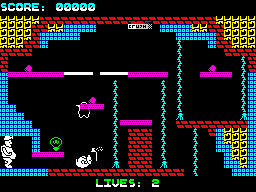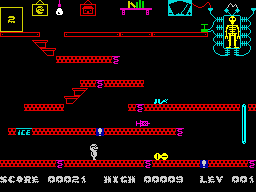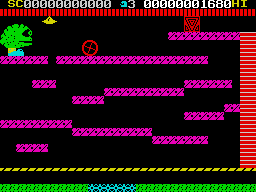| . |
HACKER'S
GUIDE |
|---|
| . |
|
Codebuster Dave Nicholls examines the
major problems
experienced by
designers of the ever-
popular 'platform'
games, discussing the
methods of program
storage that make this
kind of multi-screen
adventure possible in
just 48K.
|
|---|
Ever since Matthew Smith first
let his 'manic' imagination run
away with both him and his
assembler, a large percentage
of the games produced for the
Spectrum have been of the
'platform' variety. This
presents two major problems
for programmers wishing to
emulate the jet-setters of the
software industry. The first and
most obvious is how to design
one original screen, let alone
the 20 or more that will be
needed to satiate the needs of
today's buying public! The
second problem, and one to
which I personally find the
solutions much more
interesting, is that once you've
designed your screens, you've
got to find a way of squeezing
them - along with the rest of
the data and the code to use
them - into just 48K!
CODE CONCERN?
Before I explain the way in
which Frank N Stein, Astronut
and Monty Mole solve this
problem, there are a few other
points to note concerning the
construction of the games'
code. First off, Monty Mole has
to take my prize for being the
most untidily coded piece of
software that I've seen for ages
- several routines are
duplicated (one is even
triplicated!) and many's the
gap you'll find between the
routines. I realise that when
you're putting a game together
|
there's a great temptation to
leave in the routines you tested
it with, but a good assembler (I
use OCP's full screen one,
incidentally) makes the job of
linking all the bits and pieces
quite simple and the saving in
loading time can be
considerable. On the plus side,
Monty Mole has an interrupt
handler that's set up to work
properly with any peripherals.
It also contains some very nice
movement routines for the
graphics characters (I think the
Thumpers are great!).
Having said all that about
Monty Mole, I must admit that
in the sloppiness league
Astronut comes a close second
with even bigger gaps between
some of the routines and, the
hacker's nightmare, self-
modifying code! Frank N Stein, on the other hand, had
me fooled for a while - it took
me several minutes to realise
that what I'd mistaken for
incredibly inefficient coding
was, in fact, the output from a
Basic compiler. The compiler
itself is still in memory with the
game and, if you know where
to look, can be taken out and
used on its own - two
programs for the price of one
maybe?
Frank N Stein, incidentally,
also has an interrupt handler
that's been written separately
in machine code and, like
Monty Mole's, can be used
with all but the kitchen sink
hanging out the back of your
Speccy. My one gripe,
however, is that the routine to
handle the Kempston joystick
only recognizes the straight left
and right movements, and not
the diagonals - but I soon got
used to it.
WHAT'S IN STORE?
Returning to the storage
methods I mentioned earlier,
let me first emphasise that in all
the games I've ever looked at,
I've only really found two
different way of compressing
data - although like most
other things to do with
computing, there's always
more than one variation on a
theme.
|
The first method is to store
information about each screen
cursor position and use that to
work out what should go on to
the screen. In the case of
Monty Mole, three bits are
stored per position and these
are used to pick one of eight
attribute/pixel sets for display
(including the blank one); this
means that there can never be
more than seven distinct
platform shapes on each
screen. This is also exactly the
method used by Matthew
Smith in Manic Miner. Overall,
however, it's probably the most
inefficient of the two methods
for most cases because you
have to store information
about the empty parts of the
screen as well as the rest.
The second method, used by
Astronut and Frank N Stein,
gets around this problem by
only storing the sections of the
screen that have something in
them, ignoring all the empty
areas. This is usually
accomplished by storing the
starting screen position and the
length of each platform, and
expanding it out as a loop.
Frank N Stein does this by
PEEKing the two values and
then using them as the start and
end parameters of a FOR ...
NEXT loop. Once all the red
parts have been drawn in, the
same procedure is followed for
the slime, ice and other bits and
bobs around the screen.
Astronut varies its format
because it has different types of
platform - that is, some are
one character high and some
are two - so it reads in an extra
value that tells it which routine
to run to print the platform
correctly; other than this
though, both games work in the
same way.
One obvious thing in all
three games is that the moving
graphics characters are added
last of all, using extra data
which normally consists of a
start and end position for their
travels, along with an initial
start position. The exceptions
to this are the graphics
characters in Astronut whose
movements aren't linear - for
these a 'route' has to be
calculated as well.
|


